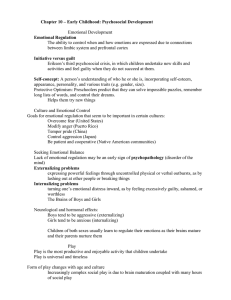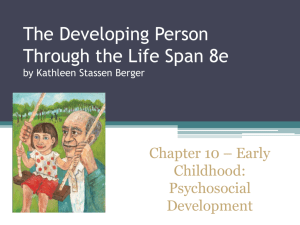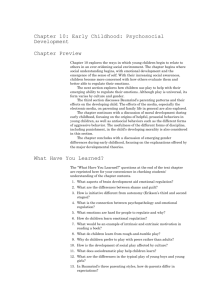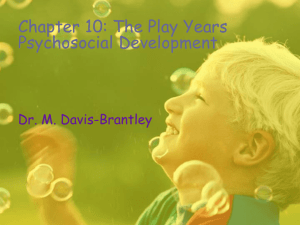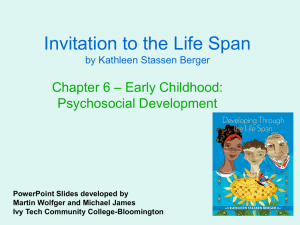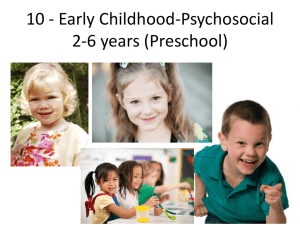Chapter 10: Early Childhood: Psychosocial Development Chapter Preview
advertisement
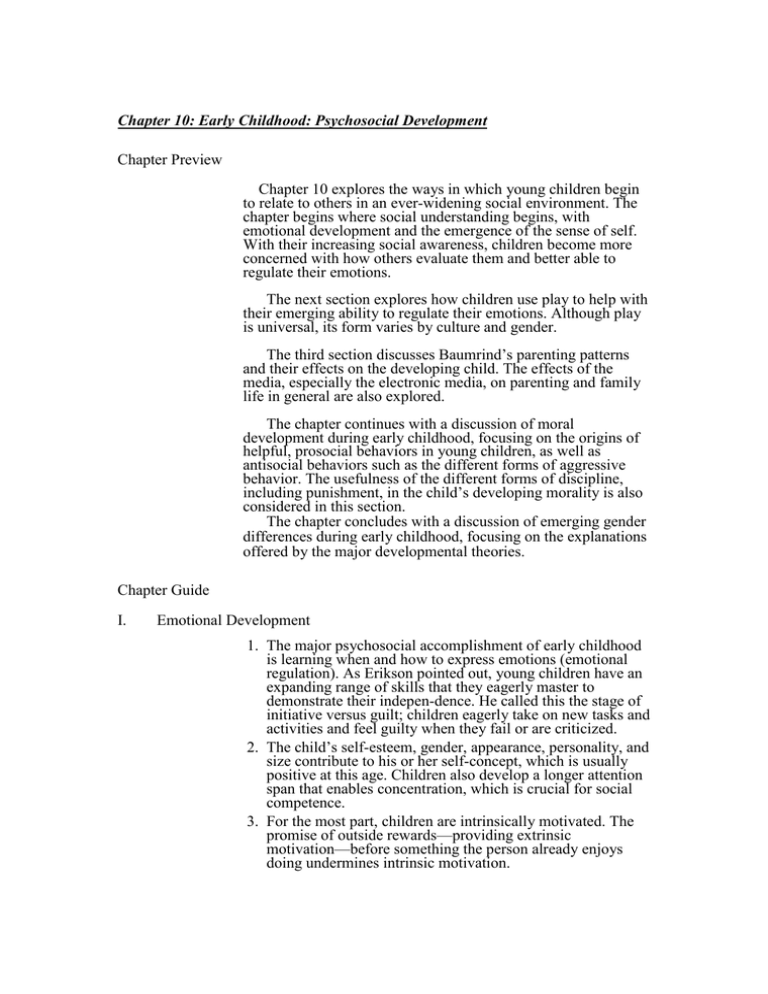
Chapter 10: Early Childhood: Psychosocial Development Chapter Preview Chapter 10 explores the ways in which young children begin to relate to others in an ever-widening social environment. The chapter begins where social understanding begins, with emotional development and the emergence of the sense of self. With their increasing social awareness, children become more concerned with how others evaluate them and better able to regulate their emotions. The next section explores how children use play to help with their emerging ability to regulate their emotions. Although play is universal, its form varies by culture and gender. The third section discusses Baumrind’s parenting patterns and their effects on the developing child. The effects of the media, especially the electronic media, on parenting and family life in general are also explored. The chapter continues with a discussion of moral development during early childhood, focusing on the origins of helpful, prosocial behaviors in young children, as well as antisocial behaviors such as the different forms of aggressive behavior. The usefulness of the different forms of discipline, including punishment, in the child’s developing morality is also considered in this section. The chapter concludes with a discussion of emerging gender differences during early childhood, focusing on the explanations offered by the major developmental theories. Chapter Guide I. Emotional Development 1. The major psychosocial accomplishment of early childhood is learning when and how to express emotions (emotional regulation). As Erikson pointed out, young children have an expanding range of skills that they eagerly master to demonstrate their indepen-dence. He called this the stage of initiative versus guilt; children eagerly take on new tasks and activities and feel guilty when they fail or are criticized. 2. The child’s self-esteem, gender, appearance, personality, and size contribute to his or her self-concept, which is usually positive at this age. Children also develop a longer attention span that enables concentration, which is crucial for social competence. 3. For the most part, children are intrinsically motivated. The promise of outside rewards—providing extrinsic motivation—before something the person already enjoys doing undermines intrinsic motivation. 4. All cultures value emotional regulation, but they differ in which emotions they believe should be controlled and in the strategies that should be used. 5. Psychopathology is an illness or disorder that involves the mind. The first signs of psychopathology in children usually involve a lack of emotional regulation. 6. Neurological advances in the prefrontal cortex are partly responsible for the greater capacity for self-control that occurs at about age 4 or 5. Emotional regulation begins with the control of impulses. Girls generally have less trouble with regulating externalizing emotions than boys do. Children who have externalizing problems and lash out at other people or things are said to be undercontrolled. Children who have internalizing problems tend to be inhibited, fearful, and withdrawn. II. III. Play 1. Between ages 2 and 6, children learn how to make and keep friends as a consequence of many hours of social play. Play varies by culture, age, and gender. An aspect of culture that shapes play is the nature of the physical setting. In cities, the scarcity of undeveloped space means that play usually occurs in child-care settings. 2. Mildred Parten distinguished five kinds of play. These include solitary play, in which a child plays alone; onlooker play, in which a child watches other children play; parallel play, in which children play together without interacting; associative play, in which children interact, but their play is not yet mutual and reciprocal; and cooperative play, in which children play together and take turns. 3. A distinctive feature of rough-and-tumble play, which is universal, is the positive facial expression that characterizes the play face. This type of play, which requires self-control, helps the prefrontal cortex to develop. 4. In sociodramatic play, children act out various roles and themes in stories of their own creation. Challenges for Parents 1. A significant influence on early psychosocial growth is the family’s approach to parenting. Diana Baumrind identified four features that differentiate styles of parenting: expressions of warmth toward offspring; strategies for discipline; how well parents communicate with their children; and parents’ maturity expectations for age-appropriate conduct. 2. Baumrind delineated three basic patterns of parenting that are based on these features: authoritarian, permissive, and authoritative (see text and Table 10.1). 3. Authoritarian parents’ word is law, not to be questioned. Maturity demands are high, and child–parent communication is low. Offspring are likely to be conscientious and obedient but unhappy. 4. Permissive parents make few maturity demands on their children but are nurturant and accepting, and they listen to 5. 6. 7. 8. 9. IV. their children. Discipline is lax. Their unhappy children are likely to lack self-control. Authoritative parents set moderate maturity demands on offspring and enforce rules, but they also listen to their children and are usually forgiving if the child falls short. Their children are likely to be successful, articulate, happy with themselves, and generous with others. In a fourth style, neglectful/uninvolved parenting, the parents are uninvolved with their children and don’t know what the children are doing. Their children tend to be immature, sad, lonely, and at risk of abuse. The child’s temperament interacts with the parent’s style, so style needs to fit the child. Also, the prevailing cultural standards powerfully affect parenting style. Most young children in the United States spend more than three hours per day using one electronic media or another. Violence on television leads to more aggressive behavior. Six major organizations (including APA) recommend that parents limit television watching, with no electronic media under age 2. Moral Development 1. Children can feel either empathy for another person, which leads to prosocial behavior, or antipathy, which leads to aggression and other forms of antisocial behavior. By age 4 or 5, most children can be deliberately prosocial or antisocial. This occurs as a result of brain maturation, emotional regulation, advances in theory of mind, and interactions with caregivers. 2. (text and Table 10.3) Developmentalists distinguish four types of aggression: instrumental aggression, used to obtain or retain a desired toy; reactive aggression, used in angry retaliation against another child; relational aggression, used to invoke psychic, not physical, pain; and bullying aggression, used in an unprovoked attack on a peer. 3. (Table 10.3) The form of aggression that is most likely to increase from age 2 to 6 is instrumental aggression. Reactive aggression can indicate a lack of emotional regulation. Adults should intervene in bullying aggression because it is a sign of poor emotional regulation. 4. (Table 10.4) In disciplining a child, parents should remember theory of mind, egocentrism, fast-mapping, and that young children are not yet logical. 5. Although physical punishment works at the moment, longitudinal research finds that children who are physically punished are likely to become bullies, delinquents, then abusive adults. Psychological control may damage a child’s achievement, creativity, and social acceptance. A commonly used method in North America is the time-out, in which the child is required to stop all activity and sit in a corner or stay indoors for a few minutes. V. Becoming Boys and Girls 1. Social scientists distinguish biological sex differences between males and females from cultural gender differences in the roles and behaviors of the two sexes. 2. Children learn about gender very early. Most 2-year-olds know whether they are boys or girls and apply gender labels. 3. By age 4, children tend to regard certain toys and roles as appropriate for one gender but not the other. 4. Young children are particularly confused about sex and gender, partly because culture emphasizes gender. 5. According to psychoanalytic theory, between the ages of 3 and 6 children are in the phallic stage. During this time boys develop the Oedipus complex and girls develop the Electra complex; these events eventually lead to the child’s identification with the same-sex parent. Boys also develop, again in self-defense, a powerful conscience, called the superego. 6. Behaviorists believe that virtually all roles, values, and morals are learned rather than inborn. a. Gender roles develop because parents and society provide reinforcement for appropriate gender-role behavior and punishment for inappropriate behavior, especially in boys. b. Children learn much of their gender and proper behavior by observing and modeling other people, especially people whom they perceive as nurturing, powerful, and similar to themselves (social learning). 7. Cognitive theorists focus on children’s understanding of male–female differences. Children develop a gender schema through concepts about their experiences. 8. Evolutionary theorists contend that sexual attraction is crucial to the basic urge to reproduce, and so males and females try to look attractive to the other sex. 9. Proponents of sociocultural theory point out that every culture teaches a particular set of values and attitudes regarding preferred behaviors for the sexes. 10. Developmentalists disagree about whether children should combine the best of both sexes (called androgyny) or continue to distinguish between the sexes.
